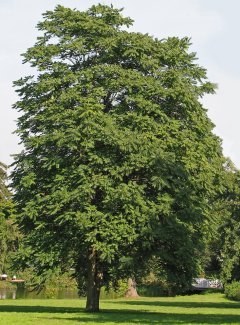China
"Mature trees can reach 80 feet in height. Ailanthus has smooth stems with pale gray bark and twigs which are light chestnut brown, especially in the dormant season. Its large compound leaves are 1-4 feet in length, alternate, and composed of 10-41 smaller leaflets. Each leaflet has one or more glandular teeth along the lower margin. The leaf margins are otherwise entire or lacking teeth. Ailanthus is a dioecious (“two houses”) plant meaning that male and female flowers occur on separate plants. Flowers occur in large terminal clusters and are small and pale yellow to greenish. Flat, twisted, winged fruits each containing a single central seed are produced on female trees in late summer to early fall and may remain on the trees for long periods of time. The wood of ailanthus is soft, weak, coarse-grained, and creamy white to light brown in color. All parts of the tree, especially the leaves and flowers, have a nutty or burned nut odor" (NPS).
Tree-of-heaven was first introduced to America by a gardener in Philadelphia, PA, in 1784, and by 1840 was commonly available from nurseries. The species was also brought into California mainly by the Chinese who came to California during the goldrush in the mid-1800s. Today it is frequently found in abandoned mining sites there. The history of ailanthus in China is as old as the written language of the country (NPS).
